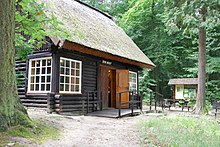Forest Museum Stendenitz
The Stendenitz Forest Museum is located in the north of Brandenburg in the middle of Ruppin Switzerland near Neuruppin on the Zermützelsee . It is one of the oldest forest museums in Germany.
location
It is in Ruppiner Switzerland. The typical landscape of Ruppin Switzerland with its lakes can be traced back to the work of the last ice age. During this time, a chain of lakes was formed north of Neuruppin. To the west of the Zermützel, Tornow and Kalksee lakes, a very hilly landscape emerged that has a diverse range of species. Cranes, beavers, sea eagles and ospreys find a habitat here.
history
Originating from a collection
The Stendenitz Forest Museum was opened in 1936. The founder and initiator was Hans Zander, who was a forester in the Rottstiel district of the Alt Ruppin Forestry Office from 1929 to 1944. As an attentive observer in the forest, he collected many interesting and curious things from nature. When the extensive collections threatened to blow up his property, he received an offer to use a wooden house near the Waldschänke Stendenitz. At this location, with the financial support of the innkeeper Grothe and other sponsors from the forest authorities, a thatched log house was built in the Russian style and inaugurated in 1936 with the exhibition “Your Forest”. In order to be able to present all collections, the building was expanded one year later. After Hans Zander was transferred to another office, the original collection was lost in 1944.
Development after the Second World War
After the end of the war, the log cabin was used as a horse stable, refugee home and holiday camp. On the occasion of a nature conservation conference in Neuruppin in 1951, the idea arose to set up an exhibition again in the forest museum building. The then district forester Willi Berger took on this task. Reconstructed and equipped with natural history objects, it was reopened and integrated into the Neuruppin Local History Museum in 1957. The exhibition was revised in 1959, 1967 and 1983 and gave an overview of the types of forest existing in Ruppin Switzerland with the associated flora and fauna. Furthermore, you got an insight into forestry, the use of wood, hunting and nature conservation. The topics were illustrated with, among other things, plant and animal preparations, hunting weapons, hunting equipment, photos and graphic representations.
Changes after 1995
The “ Historical Association of the County of Ruppin e. V. ”developed a new exhibition in 1995 with the Neuruppin Local History Museum. With the support of regional craft businesses and sponsors, the museum was redesigned and reopened in May 1996. Werner Dumann from the Historical Association took over the development of much of the exhibition content and the supervision of the museum.
- The first room of the log cabin showed the history of the forest museum, information about the geological condition and the climatic characteristics of the surrounding lakes. Explanations on the recreational value of Ruppin Switzerland and on hunting supplemented this exhibition area.
- The second room was mainly reserved for the representation of flora and fauna as well as nature and landscape protection. Numerous animal preparations could be viewed in this room.
In front of the log house are the trees planted by the forester Zander. Among other things, a false cypress and an American Colorado fir . There were also two plant gardens with small plants typical of the forest. From 1998 the Office for Forestry Alt Ruppin was responsible for the forest museum (until 1999 together with the Schutzgemeinschaft Deutscher Wald, Regionalverband Ruppin). The public relations work was intensified during this time. Forest tours and school project days under the motto "Experience nature - understand nature" were part of the offer of the forest museum.
Exhibitions
The forest museum experienced a new content orientation and conception in 2010 and 2011. The modern exhibition rooms “Zanders Forest Cabinet” and “Erlebnisraum Naturspuren” as well as a pavilion with a thatched roof next to the museum were created. The conception and design was in the hands of the engineering office "Nature and Education" from Dresden. The Forest Museum has been looked after by the Neuruppin Forestry Department of the Brandenburg State Forestry Office since 2012 .
- Zander's forest cabinet is modeled on a forester's office. Interesting details from Zander's life can be found here. You can rummage in the forester's secretary, listen in the listening corner and crack the safe.
- The natural trail adventure area leads through the habitats of Ruppin Switzerland and encourages the search for clues. Here you can feel the excitement of Zander's daughter Waldtraut on a night hike with a radio play. You get very close to hidden animals.
Forest adventure trail
A nature trail was laid out in 1960/61 near the Stendenitz Forest Museum by the nature conservation officer of the Herbert Vollrath district in collaboration with the district forester Heinz Neumann. This showed the natural interrelationships between different habitats. The brochure “Signposts through the forest museum and the nature trail” gave the necessary orientation during the tour with information on the path markings. On the occasion of the museum renovation in 1996, the nature trail was expanded and a number of themed boards were set up. In the spring of 2013, the engineering office “Nature and Education” from Dresden and the Neuruppin forestry department created a forest adventure trail. Most of the route follows the original tour. At each station there is a fictional dialogue between forester Zander and his daughter, which results in a task for the forest visitor:
See also
Web links
swell
- Signpost through the forest museum and the nature trail. Local history museum Neuruppin, 1961, DNB 576896500 .
- Werner Dumann: The Forest Museum Stendenitz. SDW Regional Association Ruppin e. V., 1999, OCLC 554396948 .
Coordinates: 53 ° 0 ′ 22.9 ″ N , 12 ° 49 ′ 10.6 ″ E
